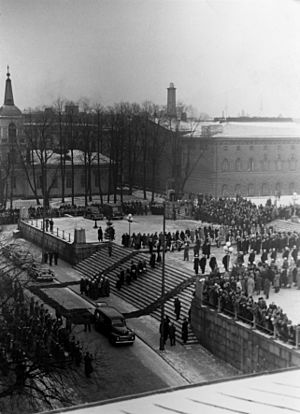Juho Kusti Paasikivi facts for kids
Quick facts for kids
Juho Kusti Paasikivi
|
|
|---|---|

Paasikivi in 1950
|
|
| 7th President of Finland | |
| In office 11 March 1946 – 1 March 1956 |
|
| Prime Minister | Mauno Pekkala Karl-August Fagerholm Urho Kekkonen Sakari Tuomioja Ralf Törngren |
| Preceded by | C. G. E. Mannerheim |
| Succeeded by | Urho Kekkonen |
| Prime Minister of Finland | |
| In office 17 November 1944 – 9 March 1946 |
|
| President | Carl Gustaf Emil Mannerheim |
| Preceded by | Urho Castrén |
| Succeeded by | Mauno Pekkala |
| In office 27 May 1918 – 27 November 1918 |
|
| Preceded by | Pehr Evind Svinhufvud |
| Succeeded by | Lauri Ingman |
| Chairman of the Senate of Finland | |
| In office 27 May 1918 – 27 November 1918 |
|
| Preceded by | Pehr Evind Svinhufvud |
| Personal details | |
| Born |
Johan Gustaf Hellsten
27 November 1870 Koski Hl, Grand Duchy of Finland, Russian Empire |
| Died | 14 December 1956 (aged 86) Helsinki, Finland |
| Resting place | Hietaniemi Cemetery |
| Political party | Finnish Party National Coalition Party |
| Spouses | Anna Matilda Forsman (desc.) Allina (Alli) Valve |
| Children | 4 |
| Alma mater | Imperial Alexander University (now University of Helsinki) |
| Profession | statesman, professor, attorney |
| Signature |  |
Juho Kusti Paasikivi (born November 27, 1870 – died December 14, 1956) was a very important Finnish leader. He served as the seventh President of Finland from 1946 to 1956. Before becoming president, he was a Prime Minister of Finland twice, an ambassador, and a member of parliament.
Paasikivi is best known for shaping Finland's foreign policy after World War II. He helped Finland stay neutral during the Cold War and build peaceful relations with its powerful neighbor, the Soviet Union. His ideas about foreign policy are still remembered today.
Contents
Early Life and Path to Politics
Birth and Childhood
Juho Kusti Paasikivi was born Johan Gustaf Hellsten in 1870. His family lived in Tampere, but he was born during his parents' business trip in Hämeenkoski. His mother died when he was four, and his father passed away when he was 14. His aunt, Kaisa Hagman, then took care of him. In 1885, he changed his name to Juho Kusti Paasikivi, which means "flagstone" in Finnish.
Education and Early Career
Young Paasikivi loved sports and was a very good student. He went to the University of Helsinki in 1890. He first studied Russian language and literature, which became very useful later in his life. He then switched to law, earning a law degree in 1902. To support himself during his studies, he worked as a teacher, lecturer, and lawyer. Around 1894, he became involved in the Fennoman movement, which promoted Finnish culture and language.
First Marriage and Family
In 1897, Paasikivi married Anna Matilda Forsman. They had four children together. After getting his law doctorate, he worked as a professor at Helsinki University for a short time.
Entering Politics
Paasikivi became the Director-in-Chief of the Treasury of the Grand Duchy of Finland in 1903, a job he held for many years. He was always involved in Finnish politics. He wanted Finland to have more control over its own affairs and a stronger government. He was against Russia's attempts to make Russian the only official language in the Russian Empire. Paasikivi was a member of the Finnish Parliament from 1907 to 1913.
Finland's Independence and Civil War

During World War I, Paasikivi left his government job and became the Chief General Manager of a bank called Kansallis-Osake-Pankki (KOP). He also served on the City Council of Helsinki.
After the Russian Revolution in 1917, Paasikivi helped create new laws for Finland. At first, he wanted Finland to have more freedom while still being part of Russia. But after another revolution in Russia, he strongly supported Finland becoming fully independent. He even wanted Finland to become a constitutional monarchy with a German prince as king, hoping this would secure Germany's support against Russia.
Finland then experienced a Finnish Civil War. Paasikivi supported the "White" government. He became prime minister in May 1918. However, Germany lost World War I, so the idea of a Finnish monarchy with a German king was dropped. Paasikivi's government resigned, and he went back to working at the bank.
As a conservative, Paasikivi was initially wary of Social Democrats and Communists in government. He even supported the Lapua movement, which wanted strong actions against the political Left. However, when the Lapua movement became too extreme and even attacked a former president, Paasikivi and many others stopped supporting them. In 1934, he became the leader of the conservative National Coalition Party. He helped the party recover and supported democracy.
Diplomatic Roles
Envoy to Sweden
After his first wife passed away, Paasikivi married Alli Valve in 1934. He then took on the important role of Envoy (ambassador) to Sweden. At this time, Finland felt isolated because of the rise of powerful, controlling governments in Germany and the Soviet Union. Sweden was seen as Finland's best hope for support.
In Sweden, Paasikivi tried to get Sweden to agree to defend Finland, or even form a defense alliance. Relations between Finland and Sweden had been difficult since the Finnish Civil War. However, things slowly improved, partly due to Paasikivi's efforts and partly because Finland's new president, Kyösti Kallio, was more open to working with Social Democrats. Despite these efforts, Sweden's support during the Winter War was helpful but not enough to prevent the war. This made Paasikivi feel his mission in Stockholm had not fully succeeded.
Envoy to Moscow
Before the Winter War, Paasikivi was Finland's representative in talks with the Soviet Union in Moscow. He realized that Joseph Stalin was not going to change his demands, so Paasikivi suggested that Finland agree to some of them to avoid war. When the war started, he became a special advisor in the Finnish government and helped lead the peace talks. He continued as Envoy in Moscow.
Paasikivi later resigned because he learned that some Finnish leaders wanted to regain lost territory with Germany's help. He disagreed with this plan and retired from public life for a second time.
Prime Minister and President
In 1941, when the Continuation War began, Paasikivi started writing his memoirs. By 1943, he believed Germany would lose the war and that Finland was in great danger. He had always been against Finland's pro-German policies, so his early attempts to start peace talks were not supported by other leaders.
From Prime Minister to President (1946)
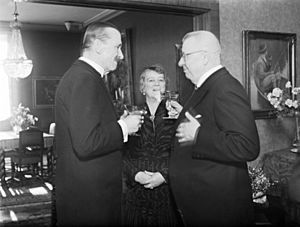
After World War II ended, Carl Gustaf Emil Mannerheim appointed Paasikivi as prime minister. For the first time, a Communist was part of the Finnish government. Paasikivi's new policies were very different from before. He wanted to build trust and peaceful relations with the Soviet Union. He made sure that school materials and public information focused on friendly relations with the Soviet Union, rather than negative portrayals.
Paasikivi had to agree to many Soviet demands, including trials for war crimes. His main goal was to show that Finland would not be a threat to the Soviet Union. When Mannerheim resigned, the Finnish Parliament chose Paasikivi to become the new President of Finland. He was 75 years old at the time.
Political Changes as President
Paasikivi had changed a lot from his earlier conservative views. He was now willing to work with Social Democrats and even Communists, as long as they acted democratically. As president, he only once allowed his own party, the Conservatives, to be in the government. He even appointed a Communist, Mauno Pekkala, as prime minister in 1946.
Dealing with Communists
Paasikivi's flexibility had limits. In 1948, when there were rumors of a communist coup, he ordered parts of the army and navy to Helsinki to protect the capital. The attempted takeover failed, and the Communists lost many seats in the next election. Paasikivi then refused to let them into the government, and they remained in opposition for many years.
"Paasikivi Doctrine"
As President, Paasikivi focused heavily on Finland's foreign relations. He believed Finland had to adapt to the power of the Soviet Union and sign treaties with them to ensure peace and freedom. This approach became known as the "Paasikivi doctrine". It helped stabilize Finland's position for decades.
Russian Language Skills
Paasikivi's ability to speak some Russian helped him communicate with Soviet leaders without needing interpreters all the time. He had studied Russian language and culture when he was younger, which also helped him understand them better.
1950 Presidential Election
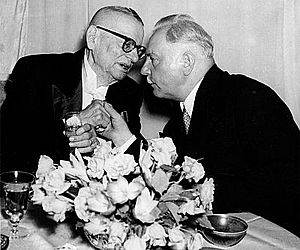
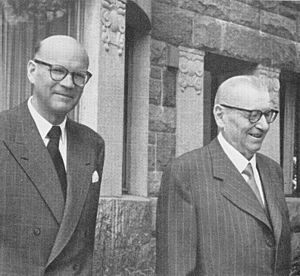
Paasikivi ran for re-election in 1950 and won easily. His second term focused more on domestic issues within Finland. The death of Joseph Stalin in 1953 made Paasikivi's job easier.
Paasikivi loved sports and was a former athlete. He had the honor of opening the 1952 Summer Olympics in Helsinki. He even gave a speech in English, which was not his strongest language, to welcome the international guests.
By the end of his second term, Finland had solved many of its problems from the war. Refugees had been settled, war payments were finished, and the Soviet Union even returned the Porkkala Naval Base to Finland in 1956.
Last-Minute 1956 Candidacy
Paasikivi did not actively seek a third term when his second term ended in March 1956. He was 85 years old. However, he was willing to serve for a couple more years if many politicians asked him to. He ran as a surprise candidate in the 1956 election but was not chosen. He felt let down by some politicians who had encouraged him to run. He passed away in December 1956, before finishing his memoirs.
Paasikivi on Banknotes
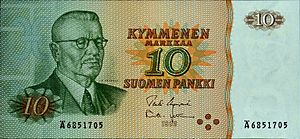
Because of his strong background in banking, Paasikivi's picture appeared on Finnish banknotes. He is one of only three Finnish presidents to be featured on the old Finnish markka banknotes.
Honours
| Coat of Arms of Juho Kusti Paasikivi | |
|---|---|
 |
|
| Armiger | Juho Kusti Paasikivi |
| Motto | "Isänmaan puolesta" ("For the Fatherland") |
National Honours
 Finland : Grand Cross with Collar of the Order of the White Rose (1946)
Finland : Grand Cross with Collar of the Order of the White Rose (1946) Finland : Grand Cross of the Order of the White Rose (1922)
Finland : Grand Cross of the Order of the White Rose (1922) Finland : Grand Cross of the Order of the Lion of Finland
Finland : Grand Cross of the Order of the Lion of Finland Finland : Grand Cross of the Order of the Cross of Liberty with Swords (October 9, 1950)
Finland : Grand Cross of the Order of the Cross of Liberty with Swords (October 9, 1950)
Foreign Honours
 Iceland : Grand Cross with Collar of the Order of the Falcon (April 24, 1954)
Iceland : Grand Cross with Collar of the Order of the Falcon (April 24, 1954) Sweden : Knight of the Royal Order of the Seraphim
Sweden : Knight of the Royal Order of the Seraphim Sweden : Order of the Polar Star
Sweden : Order of the Polar Star Norway : Grand Cross with Collar of the Order of St. Olav (November 27, 1950)
Norway : Grand Cross with Collar of the Order of St. Olav (November 27, 1950) Denmark : Knight of the Order of the Elephant
Denmark : Knight of the Order of the Elephant Soviet Union : Order of Lenin
Soviet Union : Order of Lenin Russia : Order of St. Anna
Russia : Order of St. Anna Prussia : Iron Cross
Prussia : Iron Cross France : Legion of Honour
France : Legion of Honour Poland : Order of St Stanislas
Poland : Order of St Stanislas
See also
 In Spanish: Juho Kusti Paasikivi para niños
In Spanish: Juho Kusti Paasikivi para niños
- Paasikivi–Kekkonen doctrine
- Paasikivi–Kekkonen Road
- J. K. Paasikivi memorial





